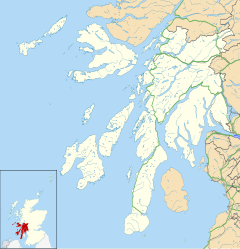| This is not a Wikipedia article: It is an individual user's work-in-progress page, and may be incomplete and/or unreliable. For guidance on developing this draft, see Wikipedia:So you made a userspace draft. Find sources: Google (books · news · scholar · free images · WP refs) · FENS · JSTOR · TWL |
Glengorm
| |
|---|---|
 Glengorm viewed from Cnoc Fuar | |
Location within Argyll and Bute | |
| Population | 22 [1] |
| OS grid reference | NM439572 |
| Civil parish |
|
| Council area | |
| Lieutenancy area | |
| Country | Scotland |
| Sovereign state | United Kingdom |
| Post town | ISLE OF MULL |
| Postcode district | PA67 |
| Dialling code | 01681 |
| Police | Scotland |
| Fire | Scottish |
| Ambulance | Scottish |
| UK Parliament | |
| Scottish Parliament | |
Glengorm (Scottish Gaelic: Gleann Gorm, meaning "blue glen") is the northernmost settlement on the Isle of Mull, off the west coast of Scotland. The settlement is situated 4 miles north of Tobermory at the end of an unnamed road, usually referred to as “Glengorm Road”. There is also a connection to Dervaig through an unpaved dirt track going across the north of the island.
The settlement is known for the large 19th century manor that it grew from, Glengorm Castle. It is a popular area for hillwalking, as there is many hills and fields with public paths nearby, and also the Glengorm Coffee Shop, the only business in the settlement. As of 2020, 22 people lived in Glengorm.[1]
Etymology
editThe area takes its name from Glengorm Castle which is situated in the estate. The name "Glengorm" is said to originate during the construction of the castle when apparently, Forsyth asked an elderly woman what he should name the manor. The story claims she suggested "Gleann Gorm", meaning blue glen. Forsyth used this name, unaware of the meaning, with the blue in the name referencing the unusual blue smoke visible from the castle, produced when the houses with seaweed and peat inside were burned when the surrounding settlements were cleared.
Glengorm Castle
editGlengorm as a settlement is centered around Glengorm Castle, as the home of the owners of the estate and the origin of the current settlement. The house was designed by Kinnear and Peddie in a Scots Baronial style. [2] Formerly being run as a guest house and wedding venue, now a family home, there is a café and shop in the former stables. The castle overlooks the Atlantic Ocean and on most days Coll and mainland Great Britain are clearly visible from the northern side of the castle, as well as Rùm, Canna, and even Barra and Uist on clear days.
Other historical sites
editDùn Ara, also known as Dùn Ara Castle or Dùn Ara Fort, is a ruined medieval castle and ancient dùn 1.5 kilometres (1 mi) northwest of Glengorm Castle on a rocky outcrop at Sorne Point. The castle can be accessed only by sea and from a path leading from Glengorm Castle. It is thought that the castle was situated well to defend the Bathing Pool, a man-made harbour possibly constructed before the castle's occupation, and that it may have seen use by the Norse.[3] In medieval times until its abandonment in 1642[4], Clan MacKinnon had control over the castle and utilized it.
References
edit- ^ a b Glengorm Castle. "Water Works". Retrieved 3 February 2024.
- ^ Historic Environment Scotland. "Glen Gorm Castle Sorn (Mishnish) (Category B Listed Building) (LB11014)". Retrieved 28 March 2019.
- ^ James Petre. "Dun Ara: a Norse-period 'harbour' in Mull?". Retrieved 3 February 2024.
- ^ Fred, Castle Finders. "Dun Ara Castle, Isle of Mull". Retrieved 3 February 2024.

